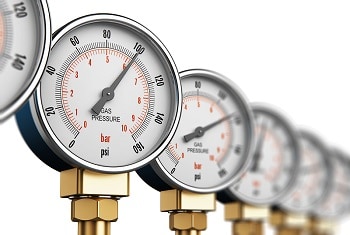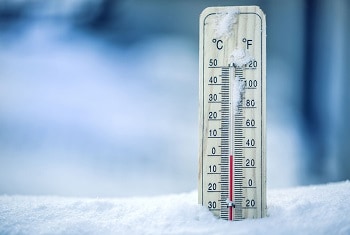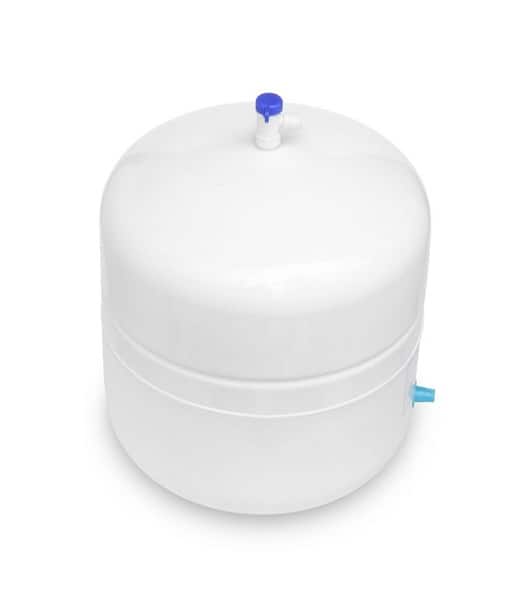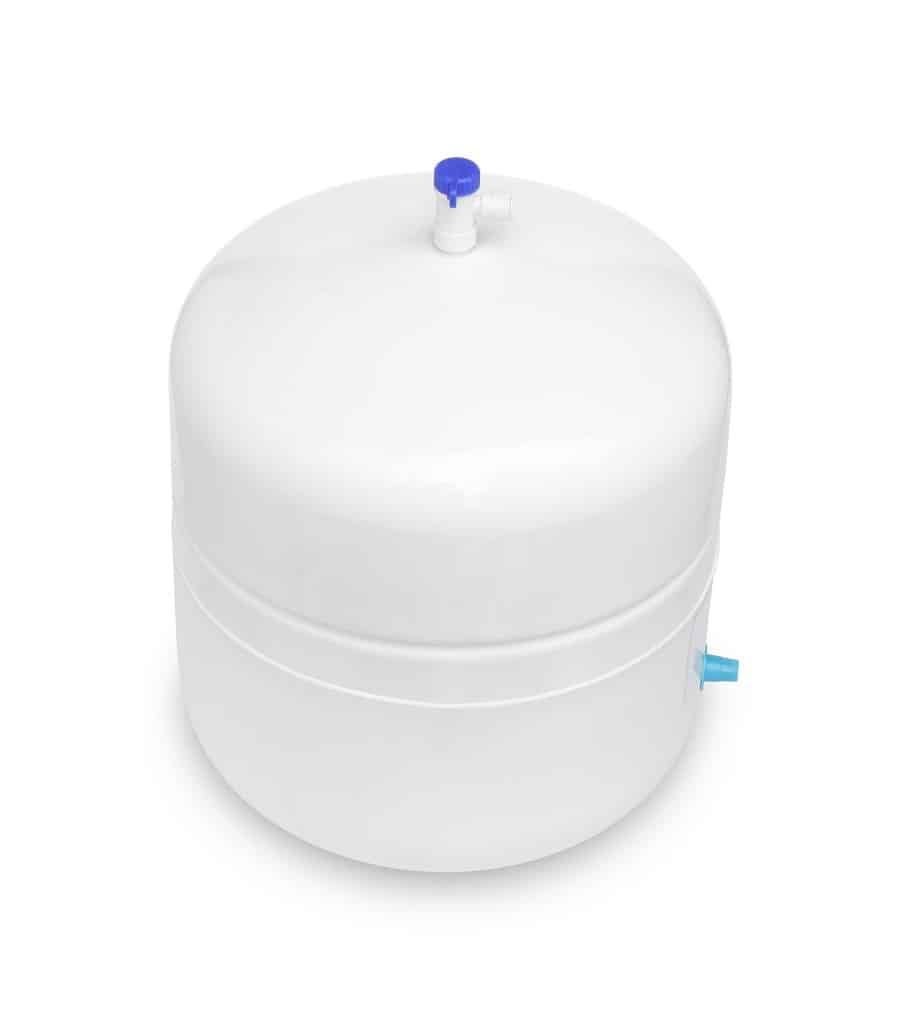UPDATED: 2/17/22
We use our reverse osmosis drinking water systems so often that we don’t think about how much water we have available until the tank goes empty. And then we start to wonder just how much water we have available in that RO storage tank. How much water does an RO tank hold?
Reverse osmosis drinking water storage tanks hold 62.5% – 80% of the tank’s total volume. A Bladder in a standard-sized tank with a total capacity of 4.0 gallons, will hold approximately 2.5 gallons (11.3652 Liters) – 3.2 ( 14.5475 Liters) of water surrounded by 1.5 gallons (6.81914 Liters) of air.
The “Actual” amount of water that a reverse osmosis water storage tank will hold will vary by the total size of the tank, the size of the water storage bladder, and the amount of air pressure surrounding the water bladder. Read on to learn how much water your RO tank should hold.
Check Out This quick video about how much water a reverse osmosis tank holds!
So, the size of the reverse osmosis storage tank doesn’t hold what it says it does?

When an air pressurized storage tank is labeled as 4 gallons, it is referring to the total capacity of the storage tank and NOT the amount of water that it is capable of storing.
This statement is actually quite accurate but the amount of water that will be held under pressure is much less than the total size of the tank.
Most reverse osmosis drinking water systems that use a water storage tank with a total capacity of 4.0 gallons will contain a water bladder that will store approximately 2.5 gallons of filtered reverse osmosis drinking water.
A slightly smaller size 3-gallon tank may only store as little as a gallon or so. The reason that we usually never notice just how little water is in the storage tank is that the reverse osmosis system is refilling the tank every time we take a glass of water from it.
Some Common sizes of reverse osmosis storage tanks and approximately how much water they will hold.
| Total Tank Volume | Optimum Water Capacity | Typical Water Capacity |
|---|---|---|
| 4.0 Gallons (Most Common) | 3.2 Gallons or 14.5475 Liters | 2.8 Gallons or 12.7291 Liters |
| 5.0 Gallons | 4.0 Gallons or 18.1844 Liters | 3.5 Gallons or 15.9113 Liters |
| 3.2 Gallons | 2.56 Gallons or 11.63799 Liters | 2.24 Gallons or 10.18324 Liters |
| 2.0 Gallons | 1.6 Gallons or 7.27374 Liters | 1.4 Gallons or 6.364526 Liters |
What affects how much water a storage tank can hold?
There are a few factors that will be determined just how much water will be stored inside of a reverse osmosis storage tank.
The incoming water pressure, incoming water temperature, and air pressure in the storage tank will all affect how much water a reverse osmosis storage tank will hold.
Air Pressure In The Tank:

A pressurized water storage tank has a bladder that has water on one side, and air on the other. If the air pressure is very low, more water will be able to enter the tank, but the low pressure will not discharge all of the water in the tank.
On the other hand, if the pressure in the tank is too high, It will keep the tank from filling and only allow a small amount of water into the tank. Get more details in my article on “How To Re-Pressurize A Reverse Osmosis Water Tank“.
Checking the pressure in your reverse osmosis storage tank each time that you change your filters will help to give you the maximum amount of stored filtered water.
Water Pressure Going Into The Tank:

The water pressure feeding the reverse osmosis system will affect how much water will be forced through the reverse osmosis membrane.
The higher the water pressure, the more water will go through the membrane and be able to fill the tank.
An empty reverse osmosis system storage should only have between 6 and 10 pounds of air pressure in it, but as the tank fills the pressure in the tank will increase dramatically.
Normally, a household reverse osmosis drinking water system will continue to produce filtered water until the pressure inside of the storage tank reaches about 2/3 of the pressure of the water feeding into the tank.
This means that a common home that has an average water pressure of 60 PSI will allow water into the pressurized reverse osmosis tank until the backpressure reaches about 40 PSI. A hydraulic shut-off valve will detect the pressure rising and shut down production when needed.
Although this does not narrow down the exact amount of water that the storage tank will hold, it will vary from house to house, and therefore affect the amount of stored water in different locations.
While this will not usually affect how the water is dispensed from the reverse osmosis drinking water faucet, reverse osmosis systems in households with lower pressure may find it difficult to feed other outlets like refrigerator ice makers.
Water temperature:

Most people do not consider the water temperature when thinking about how much water will make it into the reverse osmosis storage tank, but the temperature makes a difference in how easily water passes through a reverse osmosis membrane.
Warmer water passes through more easily and therefore will produce more stored water. But when the water temperature goes below 40 degrees, the membrane can constrict and not allow water to flow through it as freely.
Although this may sound like a small detail, it can affect your water production greatly.
Can I install an extra reverse osmosis storage tank for more water?


You can install a second storage tank for additional water storage but unless you intend to use large quantities of water (the amount of water that both tanks will hold), just a slight difference in tank pressure from one tank to the other can make the reverse osmosis empty and fill just one tank while the other tanks water stays put.
Only install a second water storage tank for high reverse osmosis water use, usually, a single tank will be fine for the average home. If you do wish to have additional water ready at any given time, I highly recommend using a larger storage tank rather than a second tank.
I realize that using a larger tank can be an issue regarding having enough room under the sink to store it, but as far as storage efficiency, a single larger tank works much better.
Want to learn more? Check out my article about “How to add a second storage tank to your reverse osmosis system”.
Does the distance between the tank and the reverse osmosis system affect how much water the tank can hold?
Any time you add more distance between the tank and the reverse osmosis system, you will be adding more water in the line going to and from the storage tank. This extra water will cause extra back pressure on the membrane of the system.
If water is not able to be forced through the reverse osmosis membrane then the system will not be able to produce filtered water.
A short distance should not cause any considerable change in water production, but if you are planning on storing your water storage tank a considerable distance from the reverse osmosis system itself, the amount of stored water may be affected.
For more on where you should have your reverse osmosis storage tank, see my article Where is an RO system installed? And why!
Because of all these variables, there is no accurate answer to the question of “How much water does an RO tank hold”, but I have found that under ideal conditions, a new reverse osmosis storage tank will hold up to 62.5 – 80 percent of the total size of the tank.
This means that a standard 4.0-gallon storage tank for a household reverse osmosis drinking water system will hold between 2.5 and 3.2 gallons of filtered revere osmosis water in it when filled to its maximum capacity.
Does the filtered water in the storage tank touch the inside of the tank?
When reverse osmosis water enters the systems storage tank, it is going into a bladder made of a substance called “butyl”.
This butyl is a durable rubber material that helps to keep the water clean and free of outside contaminants.
Since this bladder is under pressure, it keeps out air which can encourage bacteria growth.
Under normal operation, your reverse osmosis water will not make contact with any of the storage tank components except for this bladder, the shut-off valve on the tank, and the tubing leading to and from the tank.
If you are going to do any work on your reverse osmosis drinking water system, check out my article on What I Use When I Work On A Reverse Osmosis System!
Does an RO tank hold less water as it gets older?
Not exactly! As a reverse osmosis tank gets older it will begin to lose pressure in the air bladder and therefore not be able to push out all of the water that it has stored inside of the tank. By properly repressurizing your reverse osmosis storage tank, you should get plenty of filtered water for a very long time.
Is there a difference between plastic and metal storage tanks?
The only differences between plastic reverse osmosis storage tanks and metal ones are that the plastic ones are a bit heavier, and the metal ones can rust over time if they are not kept dry.
The amount of water stored in a 4-gallon reverse osmosis storage tank will be the same either way.
To Sum Up:
The amount of water that a reverse osmosis drinking water systems storage tank will hold will vary from one system to the next.
Typically, a reverse osmosis drinking water systems water storage tank will hold between 62.5% and 80% of the total volume of the storage tank depending on the air pressure in the tank, the incoming water pressure, and the temperature of the incoming water.
An average reverse osmosis storage tank will hold approximately 70% of the total volume of the storage tank during average use.


Changed filters and membrane,,have 8 1/2 PSI empty only 20 PSI after all night (10 hours ) 4 gal. tank only produces 1 1/2 gals. TDS reading is about the same as tap (around 400 ) Does not drain any water when filling, cleaned hose to drain ( little bit yuky at end near drain ) Culligan AC-30 12 years old. Had Culligan service it until about 3 years ago and was doing it myself. Just wondered what you thought before I tear into the top to see if it is clogged there somewhere.
Gary
Hello Gary, and thank you for the question.
This could be a tricky one! My first concern is that it is not draining at all. Let’s remove the drain line from the drain saddle and make sure that the drain saddle hole is lined up with the drill hole. If you can, run the drain line directly into the sink drain so you can watch for draining.
Give the tank a shake to see if it is waterlogged (totally full of water). If it is totally full, the bladder inside of the tank may be bad and you have to replace the tank (RO Storage Tanks). It makes sense that you are only getting 1.5 gallons out of a 4-gallon tank that is 12 years old, it would only give 2 gallons or so at best.
Let’s drop the “empty tank” pressure to 7, for now, to give the tank the best chance to fill correctly.
Make sure the feed water is working correctly, weak water pressure will cause the membrane not to filter properly, and the TDS from the RO will often be just slightly lower than the tap TDS. Shut off your water feed and remove the feed line from your system. Put the end in a bucket and turn the water back on. The water should shoot out with strong, steady pressure that will spray far if you put your thumb over it.
Culligan RO systems often have a thin drain line restrictor capillary tube in the drain line where it connects to the system itself (it’s a thin tube with a cap with a hole in it at one end), then take off the drain line from the system and make sure the restrictor is clear (if your system has one). You may need to replace it if you can’t clear it.
If the system is not draining rejected water (the bad water), it is not making good water.
I don’t think that there is going to be a clog in the main module of the system, so save that for last. Make sure the water pressure going in is strong and the drain water is going out. Look for kinks in the lines.
There is also an auto shut-off that could be sticking.
Hope this helps, reply if you find anything else.
Paul